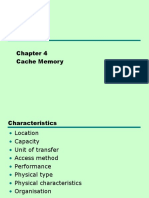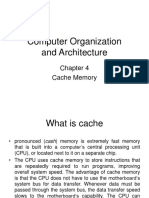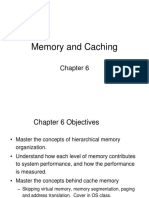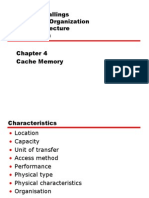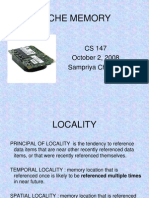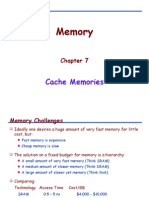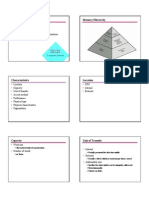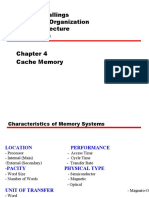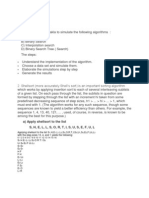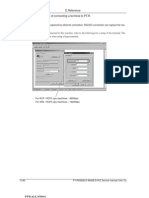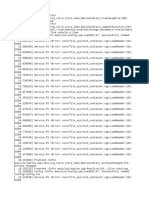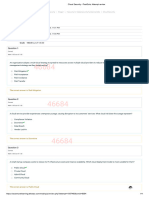Cache memory
Direct Cache Memory
Associate Cache Memory
Set Associative Cache Memory
�How can one get fast memory with less expense?
It is possible to build a computer which uses only
static RAM (large capacity of fast memory)
This would be a very fast computer
But, this would be very costly
It also can be built using a small fast memory for
present reads and writes.
Add a Cache memory
�Locality of Reference Principle
During the course of the execution of a program,
memory references tend to cluster
- e.g. programs - loops, nesting,
data
strings, lists, arrays,
This can be exploited with a Cache memory
�Cache Memory Organization
Cache - Small amount of fast memory
Sits between normal main memory and CPU
May be located on CPU chip or in system
Objective is to make slower memory system look like fast memory.
There may be more levels of cache (L1, L2,..)
�Cache Operation Overview
CPU requests contents of memory location
Cache is checked for this data
If present, get from cache (fast)
If not present, read required block from main memory to cache
Then deliver from cache to CPU
Cache includes tags to identify which block(s) of main memory
are in the cache
�Cache Read Operation - Flowchart
�Cache Design Parameters
Size of Cache
Size of Blocks in Cache
Mapping Function how to assign blocks
Write Policy - Replacement Algorithm when blocks
need to be replaced
�Size Does Matter
Cost
More cache is expensive
Speed
More cache is faster (up to a point)
Checking cache for data takes time
�Typical Cache Organization
�Cache/Main Direct Caching Memory
Structure
�Direct Mapping Cache Organization
�Direct Mapping Summary
Each block of main memory maps to only one cache
line
i.e. if a block is in cache, it must be in one specific place
Address is in two parts
- Least Significant w bits identify unique word
- Most Significant s bits specify which one memory block
All but the LSBs are split into
a cache line field r and
a tag of s-r (most significant)
�Example Direct Mapping Function
16MBytes main memory
i.e. memory address is 24 bits
- (224=16M) bytes of memory
Cache of 64k bytes
i.e. cache is 16k
- (214) lines of 4 bytes each
Cache block of 4 bytes
i.e. block is 4 bytes
- (22) bytes of data per block
�Example Direct Mapping Address Structure
Tag s-r
Line or Slot r
14
24 bit address
2 bit word identifier (4 byte block)
likely it would be wider
22 bit block identifier
8 bit tag (=22-14)
14 bit slot or line
No two blocks sharing the same line have the same Tag field
Check contents of cache by finding line and checking Tag
Word w
2
�Illustration
of Example
�Direct Mapping pros & cons
Pros:
Simple
Inexpensive
?
Cons:
One fixed location for given block
If a program accesses 2 blocks that map to
the same line repeatedly, cache misses are
very high thrashing & counterproductivity
?
�Associative Cache Mapping
A main memory block can load into any line of cache
The Memory Address is interpreted as tag and word
The Tag uniquely identifies block of memory
Every lines tag is examined for a match
Cache searching gets expensive/complex or slow
�Fully Associative Cache Organization
�Associative Caching Example
�Comparison of Associate to Direct Caching
Direct Cache Example:
8 bit tag
14 bit Line
2 bit word
Associate Cache Example:
22 bit tag
2 bit word
�Set Associative Mapping
Cache is divided into a number of sets
Each set contains a number of lines
A given block maps to any line in a given set
e.g. Block B can be in any line of set i
e.g. with 2 lines per set
We have 2 way associative mapping
A given block can be in one of 2 lines in only
one set
�Two Way Set Associative Cache Organization
�2 Way Set Assoc Example
�Comparison of Direct, Assoc, Set Assoc Caching
Direct Cache Example (16K Lines):
8 bit tag
14 bit line
2 bit word
Associate Cache Example (16K Lines):
22 bit tag
2 bit word
Set Associate Cache Example (16K Lines):
9 bit tag
13 bit line
2 bit word
�Replacement Algorithms (1)
Direct mapping
No choice
Each block only maps to one line
Replace that line
�Replacement Algorithms (2)
Associative & Set Associative
Likely Hardware implemented algorithm (for speed)
First in first out (FIFO) ?
replace block that has been in cache longest
Least frequently used (LFU) ?
replace block which has had fewest hits
Random ?
�Write Policy Challenges
Must not overwrite a cache block unless main memory
is correct
Multiple CPUs/Processes may have the block cached
I/O may address main memory directly ?
(may not allow I/O buffers to be cached)
�Write through
All writes go to main memory as well as cache
(Typically 15% or less of memory references are
writes)
Challenges:
Multiple CPUs MUST monitor main memory traffic to
keep local (to CPU) cache up to date
Lots of traffic may cause bottlenecks
Potentially slows down writes
�Write back
Updates initially made in cache only
(Update bit for cache slot is set when update occurs
Other caches must be updated)
If block is to be replaced, memory overwritten only if
update bit is set
( 15% or less of memory references are writes )
I/O must access main memory through cache or
update cache
�Coherency with Multiple Caches
Bus Watching with write through
1) mark a block as invalid when another
cache writes back that block, or
2) update cache block in parallel with
memory write
Hardware transparency
(all caches are updated simultaneously)
I/O must access main memory through cache or update cache(s)
Multiple Processors & I/O only access non-cacheable memory
blocks
�Choosing Line (block) size
8 to 64 bytes is typically an optimal block
(obviously depends upon the program)
Larger blocks decrease number of blocks in a given cache size,
while including words that are more or less likely to be accessed
soon.
Alternative is to sometimes replace lines with adjacent blocks
when a line is loaded into cache.
Alternative could be to have program loader decide the cache
strategy for a particular program.
�Multi-level Cache Systems
As logic density increases, it has become advantages and
practical to create multi-level caches:
1) on chip
2) off chip
L2 cache may not use system bus to make caching faster
If L2 can potentially be moved into the chip, even if it
doesnt use the system bus
Contemporary designs are now incorporating an on
chip(s) L3 cache . . . .
�Split Cache Systems
Split cache into:
1) Data cache
2) Program cache
Advantage:
Likely increased hit rates
- data and program accesses display different behavior
Disadvantage:
Complexity
�Intel Caches
80386 no on chip cache
80486 8k using 16 byte lines and four way set associative organization
Pentium (all versions) two on chip L1 caches
Data & instructions
Pentium 3 L3 cache added off chip
Pentium 4
L1 caches
8k bytes
64 byte lines
four way set associative
L2 cache
Feeding both L1 caches
256k
128 byte lines
8 way set associative
L3 cache on chip
�Pentium 4 Block Diagram
�Intel Cache Evolution
Problem
Solution
Processoronwhichfeature
firstappears
Externalmemoryslowerthanthesystembus.
Addexternalcacheusingfaster
memorytechnology.
386
Increasedprocessorspeedresultsinexternalbusbecoming
abottleneckforcacheaccess.
Moveexternalcacheonchip,
operatingatthesamespeedasthe
processor.
486
Internalcacheisrathersmall,duetolimitedspaceonchip
AddexternalL2cacheusingfaster
technologythanmainmemory
486
Createseparatedataandinstruction
caches.
Pentium
Createseparatebacksidebusthatruns
athigherspeedthanthemain(front
side)externalbus.TheBSBis
dedicatedtotheL2cache.
PentiumPro
MoveL2cacheontotheprocessor
chip.
PentiumII
AddexternalL3cache.
PentiumIII
MoveL3cacheonchip.
Pentium4
ContentionoccurswhenboththeInstructionPrefetcher
andtheExecutionUnitsimultaneouslyrequireaccessto
thecache.Inthatcase,thePrefetcherisstalledwhilethe
ExecutionUnitsdataaccesstakesplace.
Increasedprocessorspeedresultsinexternalbusbecoming
abottleneckforL2cacheaccess.
Someapplicationsdealwithmassivedatabasesandmust
haverapidaccesstolargeamountsofdata.Theonchip
cachesaretoosmall.
�PowerPC Cache Organization (Apple-IBM-Motorola)
601 single 32kb 8 way set associative
603 16kb (2 x 8kb) two way set associative
604 32kb
620 64kb
G3 & G4
64kb L1 cache
8 way set associative
256k, 512k or 1M L2 cache
two way set associative
G5
32kB instruction cache
64kB data cache
�PowerPC G5 Block Diagram
�Comparison of Cache Sizes
Processor
Type
YearofIntroduction
Primarycache(L1)
2ndlevelCache(L2)
3rdlevelCache(L3)
IBM360/85
Mainframe
1968
16to32KB
PDP11/70
Minicomputer
1975
1KB
VAX11/780
Minicomputer
1978
16KB
IBM3033
Mainframe
1978
64KB
IBM3090
Mainframe
1985
128to256KB
Intel80486
PC
1989
8KB
Pentium
PC
1993
8KB/8KB
256to512KB
PowerPC601
PC
1993
32KB
PowerPC620
PC
1996
32KB/32KB
PowerPCG4
PC/server
1999
32KB/32KB
256KBto1MB
2MB
IBMS/390G4
Mainframe
1997
32KB
256KB
2MB
IBMS/390G6
Mainframe
1999
256KB
8MB
Pentium4
PC/server
Highendserver/
supercomputer
Supercomputer
2000
8KB/8KB
256KB
2000
64KB/32KB
8MB
2000
8KB
2MB
PC/server
2001
16KB/16KB
96KB
4MB
SGIOrigin2001
Highendserver
2001
32KB/32KB
4MB
Itanium2
PC/server
2002
32KB
256KB
6MB
IBMPOWER5
Highendserver
2003
64KB
1.9MB
36MB
CRAYXD1
Supercomputer
2004
64KB/64KB
1MB
IBMSP
CRAYMTAb
Itanium





